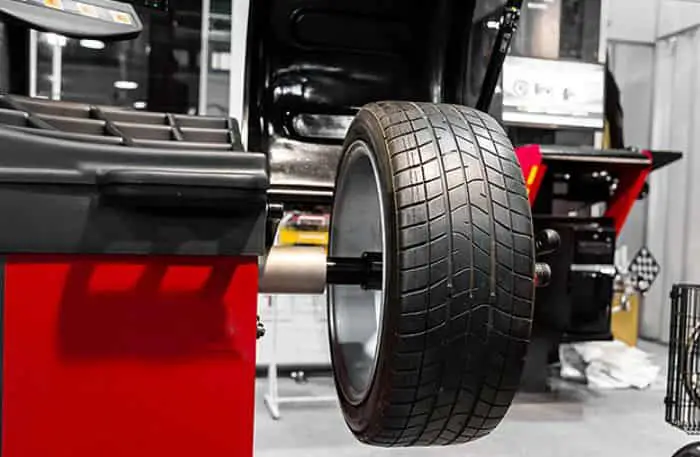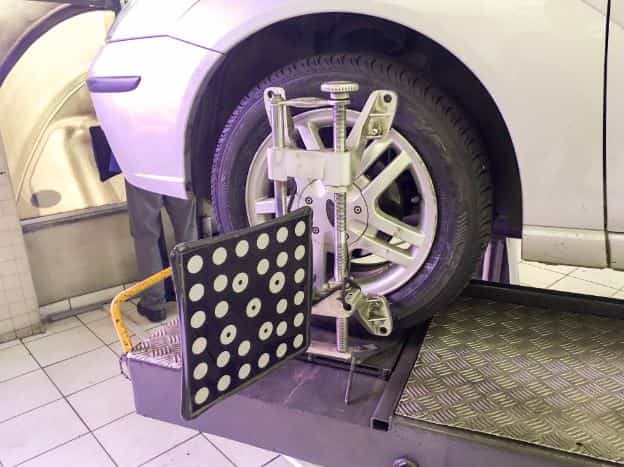There are two services that aid the functionality of your vehicle: wheel balancing vs alignment. Without these services, your car’s wheels stand the risk of being unevenly balanced and may point in a different direction.
However, many people often confuse or interchange the concept of wheel alignment and balancing. Thankfully, this article will help you to clarify this misconception. We will explore the differences between wheel balancing vs alignment, their benefits, and many more.
Without further ado, let’s begin.
What Are Wheel Balancing Vs Alignment?
What Is Wheel Balancing?

As the word “balancing” suggests, it has to do with the proper balancing of your vehicle’s wheels. To put it simply, this procedure is carried out to balance your car’s wheel assembly and tire weight. Your wheels must be evenly balanced to roll without hindrances.
However, this poses a problem. Even with modern design and technology, making a tire or wheel that balances all-round is a bit of an impossibility. By implication, some areas of your vehicle’s wheels may be heavier or lighter due to uneven weight distribution. This makes the wheel of your car vibrate when in motion. Fortunately, wheel balancing offers a solution to this issue. It utilizes precision machinery which will spin each tire and wheel in search of the heavier part of the wheel.
As soon as the mechanic locates the part of the wheel that weighs more, they will use bonding cement to increase the weight of the lighter parts. Thus, making them balanced.
What Is Wheel Alignment?

Analogous to wheel balancing, wheel alignment has to do with the suspension system (system connecting a car to its wheels) of your car. Your vehicle’s suspension system is responsible for the direction and angle your wheels roll towards.
This implies that wheel alignment services are only a necessity when you have misaligned wheels. To sum it up, unlike wheel balancing, wheel alignment is not a modification to the wheels of your vehicle. Instead, it is an adjustment to the suspension system of your car.
Checkout: What are the Types of Suspension Springs Used In Vehicles?
Benefits of Wheel Balancing Vs Alignment
Getting rid of the risk of premature wear on your car tires is one significant benefit of having your wheels balanced. It also improves the performance of your wheels/tires while lengthening their lifespan. According to experts, it should be done after every 5,000 to 6,000 miles to get the full benefits of wheel balancing. Here are some other perks that come with having a balanced wheel:
- Smoother and safer rides
- Reduced tire wear
- Less strain on the drivetrain
- Protection for your vehicle’s suspension
Similar to wheel balancing, technicians recommend that you inspect the wheel alignment of your car every 6,000 miles or twice yearly. Some of the benefits of wheel alignment are as follows:
- Enhanced vehicle handling
- Improved fuel economy/efficiency
- Increased lifespan
- Lesser damage to other components (misaligned wheels can damage other parts of the wheel assembly)
Don’t miss out: Comparison Between Drum Brake and Disc Brake [Explained]
Signs Your Car Needs Wheel Balancing or Wheel Alignment
All problems come with signs and symptoms, and it isn’t any different with wheel balancing and alignment. Here are some of the signs indicating the need for the wheel balancing service.
- Premature and uneven tread wear
- Shaking/vibrations in your seat
- Shaking/vibrations of the steering wheel
- Vibrations in your vehicle’s floorboard
Here’s something to keep in mind: If you feel vibrations originating from the steering system of your car, it implies that your front wheels are not balanced. Also, if the vibrations come from the vehicle’s seat, it is a pointer that your rear wheels need to be balanced. You should know that external factors such as hitting a curb or pothole can also result in an unbalanced wheel.
Distinct from wheel balancing, the symptoms of a misaligned wheel are more conspicuous. Below we have provided you with these signs.
- Your car’s steering wheel tilts off-center when driving
- Increased vibrations from the steering wheel when accelerating
- Uneven and premature wear
- Your vehicle is pulled towards one side of the road
Any of the symptoms mentioned above is a clear warning that your wheels are either unbalanced or misaligned. We recommend that you visit the garage as soon as you notice any symptoms. Experts suggest balancing and aligning your wheels after a tire repair or rotation to be on the safe side.
Read Also: 9 Different Types of Differential Systems & How They Work?
How Long Do Wheel Balancing And Wheel Alignment Take?
Carrying out the wheel balancing or alignment is not a lengthy process. It takes roughly 30-60 minutes to balance your wheels. However, several factors can affect how long it takes to get your wheels balanced. They include the terrain you drive in, your driving habit, and the tire’s condition. To hit the nail on the head, it would take a longer time to balance a wheel that is in a terrible state.
Compared to wheel balancing, it takes about an hour to get your wheels aligned. Also, the time remains the same whether you drive a two-wheel drive or four-wheel drive. Note that you may need to replace some parts of your vehicle’s suspension system that are badly damaged. This means that you will spend more time on it.
Cost of Wheel Balancing Vs Alignment
The cost of a wheel alignment depends on the type of vehicle you have and the garage shop. On average, it costs between $100 to $200 to get all four of your wheels aligned. On the flip side, the cost for a 4-wheel balancing service is anywhere from $40–$100.
Conclusion
Wheel balancing and alignment are two maintenance routines that you can’t do without as a car owner in the long run. From safer rides to a longer lifespan, the benefits of balancing and alignment of your wheels are extensive.
Thanks to this article, you can clearly distinguish between wheel balancing and alignment. To ensure your safety while driving, how about you pay the garage a visit for a wheel inspection. That way, you save yourself a lot of time and trouble.
So for now, I hope I’ve covered everything you were looking for about “Wheel Balancing vs Alignment”. If you still have any doubts or questions regarding this topic, leave a comment below I’ll definitely reply. If you liked it, then share this with your friends.
Want free PDFs direct to your inbox? Then subscribe to our newsletter.
You might like to read more car engine parts in our blog: